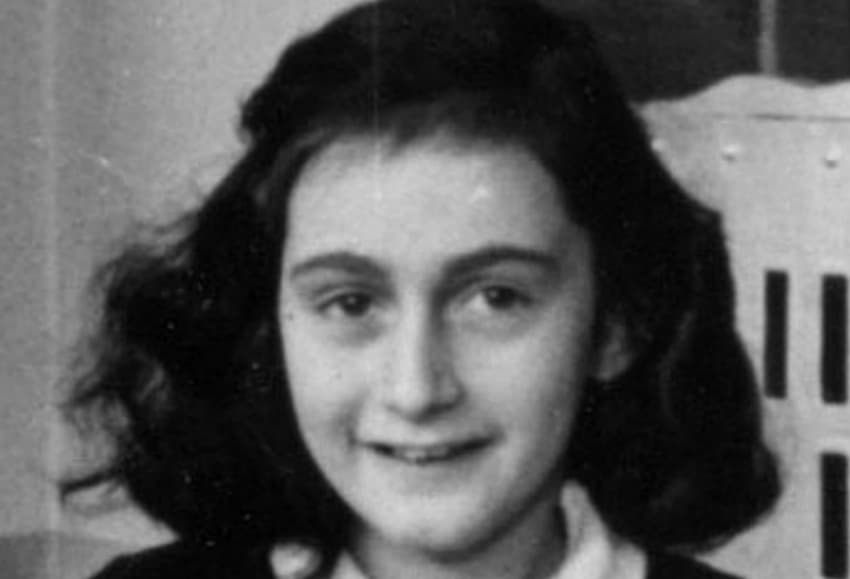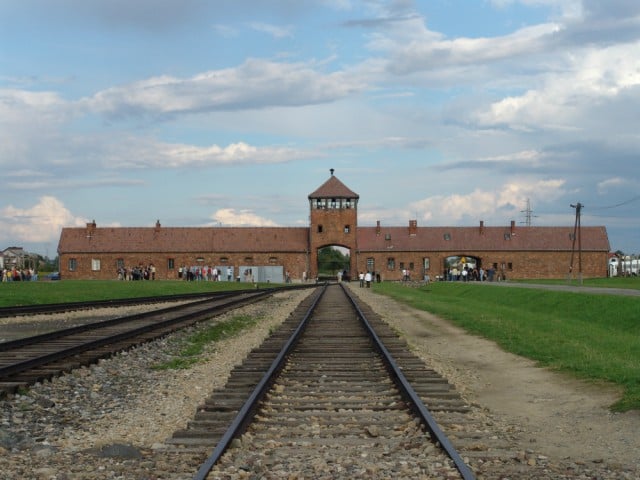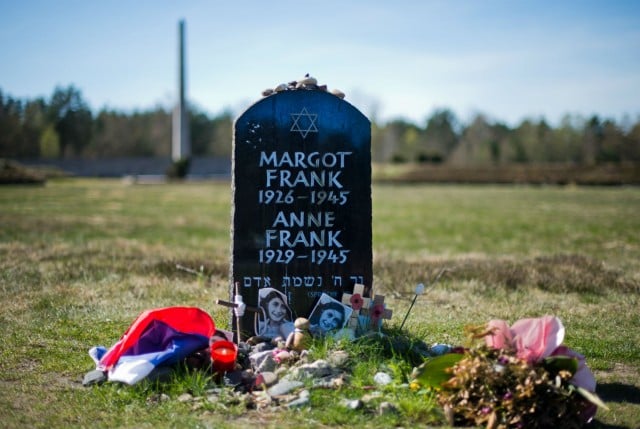Anne Frank: her life after the diary ended

March 12th marks the 71st anniversary of Anne Frank's death. Thanks to her intimate diary, the world still knows about her life in hiding. But few know the tragic story of her life after being captured. “I was so sorry Anne didn't know, because she thought that she was the last one of the family - and then you don't make such a big effort if you know there is no one left,” Hanneli Goslar recalled years later in an interview when describing her friend Anne Frank's death.
Goslar and Frank were both imprisoned in Bergen-Belsen concentration camp during the winter of 1944-45. The two girls were separated from one another, but could speak under the cover of darkness through a barbed wire fence.
A weak and sick Anne had just told her that she had no one left. As far as she knew, both her parents had died in Auschwitz. Her sister was still with her, but she was too weak to even come to the fence to talk to Goslar.
What Frank didn't know was that her father was still alive and would survive the war.
Otto Frank escaped death when the family arrived in Auschwitz in the autumn of 1944. All men over 55 were sent to the gas chambers, but Otto had stayed relatively healthy during the family's time in hiding. The SS officers mistook him for a younger man and sent him to the labour camp instead.
When he made it back to Amsterdam after the war, Otto discovered that none of his family had survived. His daughter Anne died weeks before British forces liberated Bergen-Belsen.
Finally caught
The Frank family had managed to escape the Nazis' clutches for most of the war.
But on August 4th 1944, Anne, her sister Margot and her parents Edith and Otto were arrested by the Gestapo, who acted on a tip-off to search their hide-out in Amsterdam. After two years living in the shadows, they had finally been caught.
The family had gone into hiding - along with Hermann and Auguste van Pels, their son Peter, and dentist Fritz Pfeffer - to escape a Nazi order for Margot to go into forced labour.
The group hid in rooms connected to Otto's Amsterdam office by a door concealed behind a bookshelf. In her diary, Anne nicknamed the hide-out "the Annex."
After their arrest, the group was taken to an Amsterdam prison for interrogation, before being transferred to Westerbork holding camp in the northeast of the Netherlands.
Although the conditions in Westerbork were far from pleasant, the Franks could have stayed there in relative safety and lived out the war. Instead they were deported to Auschwitz on the very last train to leave the camp on September 3rd 1944.
Life in Auschwitz
When the train arrived at the death camp, Otto was separated from his wife and children. It was the last time he would see them.
The new arrivals were separated into those who were able to work and those who were deemed unfit. Over half of the 1,000 people who arrived with the Franks were gassed, including all those under 15.
Anne had turned 15 three months earlier and was spared the gas-chambers. But inside the camp, she was stripped naked, and her head was shaved.
At the end of October, her mother Edith was selected to go to a labour camp in Silesia, which had better conditions than Auschwitz. Anne was not allowed to go due to the scabies she'd developed, and so her mother and sister decided to stay with her.
A few days later, Edith was chosen to be gassed and was separated from her daughters. But she managed to escape before reaching the gas chambers, fleeing to another part of the camp where she hid all the food she could find for when her daughters' returned. They never did. Edith Frank died of exhaustion on January 6th 1945.
 The gate of Auschwitz-Birkenau. Photo: Michel Zacharz AKA Grippenn/Wikimedia Commons
The gate of Auschwitz-Birkenau. Photo: Michel Zacharz AKA Grippenn/Wikimedia Commons
Transported to Bergen-Belsen
In November the Frank sisters were transported again. Along with Auguste van Pels from the Annex, they were taken to Bergen-Belsen and put in make-shift tents.
Both girls were already weak and sick. As the camp became more crowded, their health deteriorated further.
Goslar, who was already housed in the barracks, remembered how a storm destroyed the tents one night, leaving the new arrivals to sit in the freezing mud and rain. Those who survived were moved into barracks. But they were separated from other inmates by barbed wire so that they couldn't tell of the horrors they had seen at Auschwitz.
It was at this point that Goslar found out that her friend was in the camp.
Soon after, she went to the fence at night and called for her friend. Auguste was on the other side and replied "I will get Anne. I cannot get Margot because she is too weak to walk, but I will get Anne."
“After several minutes, a very weak and sad voice calls me, and it was Anne. The first thing we did was cry,” Goslar recounted.
“I have nobody left," a desperate Frank told her.
At the end of their first meeting, Frank begged Goslar for food and provisions, saying she had run out and was starving. Her friend promised that she would meet her a few days later with all that she could find.
Goslar went back to her barracks and collected scraps of food and other items like gloves. When she met Frank again, she threw the bundle over the fence. But another woman caught it and ran away with it. Frank, who was trying to survive on the tiny amounts of food that she was given by guards, was left on the floor in tears.
A few days later they tried again, and this time Anne caught the bundle, thanked Goslar, and walked off. It was the last time Goslar saw or heard from her.
It is presumed that Anne Frank died of typhus not long after that final meeting. The disease was sweeping the camp and killed as many as 17,000 people. She reportedly died a few days after Margot in early March 1945. Both their bodies were buried in an unknown mass grave.
Although the exact day of Anne Frank's death isn't known, March 12th has been chosen as the date to mark it.
On April 15th 1945, British forces freed the camp.
 The memorial to Anne and Margot Frank in Bergen-Belsen. Photo: DPA
The memorial to Anne and Margot Frank in Bergen-Belsen. Photo: DPA
Immortalized by Otto
Otto Frank survived four and a half months at Auschwitz before the camp was liberated by the Soviet army towards the end of January 1945.
After he returned to Amsterdam and found that everyone else who hid in the Annex had died, Otto was given Anne's diary by family friend Miep Gies, who had saved it after the Gestapo raid.
He edited the diary and published it as the book we know so well today. He did so to remember the life of his fallen daughter, and also to serve as a reminder of the horrors of fascism and extreme nationalism. He died in 1980 at the age of 91.
Comments
See Also
“I was so sorry Anne didn't know, because she thought that she was the last one of the family - and then you don't make such a big effort if you know there is no one left,” Hanneli Goslar recalled years later in an interview when describing her friend Anne Frank's death.
Goslar and Frank were both imprisoned in Bergen-Belsen concentration camp during the winter of 1944-45. The two girls were separated from one another, but could speak under the cover of darkness through a barbed wire fence.
A weak and sick Anne had just told her that she had no one left. As far as she knew, both her parents had died in Auschwitz. Her sister was still with her, but she was too weak to even come to the fence to talk to Goslar.
What Frank didn't know was that her father was still alive and would survive the war.
Otto Frank escaped death when the family arrived in Auschwitz in the autumn of 1944. All men over 55 were sent to the gas chambers, but Otto had stayed relatively healthy during the family's time in hiding. The SS officers mistook him for a younger man and sent him to the labour camp instead.
When he made it back to Amsterdam after the war, Otto discovered that none of his family had survived. His daughter Anne died weeks before British forces liberated Bergen-Belsen.
Finally caught
The Frank family had managed to escape the Nazis' clutches for most of the war.
But on August 4th 1944, Anne, her sister Margot and her parents Edith and Otto were arrested by the Gestapo, who acted on a tip-off to search their hide-out in Amsterdam. After two years living in the shadows, they had finally been caught.
The family had gone into hiding - along with Hermann and Auguste van Pels, their son Peter, and dentist Fritz Pfeffer - to escape a Nazi order for Margot to go into forced labour.
The group hid in rooms connected to Otto's Amsterdam office by a door concealed behind a bookshelf. In her diary, Anne nicknamed the hide-out "the Annex."
After their arrest, the group was taken to an Amsterdam prison for interrogation, before being transferred to Westerbork holding camp in the northeast of the Netherlands.
Although the conditions in Westerbork were far from pleasant, the Franks could have stayed there in relative safety and lived out the war. Instead they were deported to Auschwitz on the very last train to leave the camp on September 3rd 1944.
Life in Auschwitz
When the train arrived at the death camp, Otto was separated from his wife and children. It was the last time he would see them.
The new arrivals were separated into those who were able to work and those who were deemed unfit. Over half of the 1,000 people who arrived with the Franks were gassed, including all those under 15.
Anne had turned 15 three months earlier and was spared the gas-chambers. But inside the camp, she was stripped naked, and her head was shaved.
At the end of October, her mother Edith was selected to go to a labour camp in Silesia, which had better conditions than Auschwitz. Anne was not allowed to go due to the scabies she'd developed, and so her mother and sister decided to stay with her.
A few days later, Edith was chosen to be gassed and was separated from her daughters. But she managed to escape before reaching the gas chambers, fleeing to another part of the camp where she hid all the food she could find for when her daughters' returned. They never did. Edith Frank died of exhaustion on January 6th 1945.
The gate of Auschwitz-Birkenau. Photo: Michel Zacharz AKA Grippenn/Wikimedia Commons
Transported to Bergen-Belsen
In November the Frank sisters were transported again. Along with Auguste van Pels from the Annex, they were taken to Bergen-Belsen and put in make-shift tents.
Both girls were already weak and sick. As the camp became more crowded, their health deteriorated further.
Goslar, who was already housed in the barracks, remembered how a storm destroyed the tents one night, leaving the new arrivals to sit in the freezing mud and rain. Those who survived were moved into barracks. But they were separated from other inmates by barbed wire so that they couldn't tell of the horrors they had seen at Auschwitz.
It was at this point that Goslar found out that her friend was in the camp.
Soon after, she went to the fence at night and called for her friend. Auguste was on the other side and replied "I will get Anne. I cannot get Margot because she is too weak to walk, but I will get Anne."
“After several minutes, a very weak and sad voice calls me, and it was Anne. The first thing we did was cry,” Goslar recounted.
“I have nobody left," a desperate Frank told her.
At the end of their first meeting, Frank begged Goslar for food and provisions, saying she had run out and was starving. Her friend promised that she would meet her a few days later with all that she could find.
Goslar went back to her barracks and collected scraps of food and other items like gloves. When she met Frank again, she threw the bundle over the fence. But another woman caught it and ran away with it. Frank, who was trying to survive on the tiny amounts of food that she was given by guards, was left on the floor in tears.
A few days later they tried again, and this time Anne caught the bundle, thanked Goslar, and walked off. It was the last time Goslar saw or heard from her.
It is presumed that Anne Frank died of typhus not long after that final meeting. The disease was sweeping the camp and killed as many as 17,000 people. She reportedly died a few days after Margot in early March 1945. Both their bodies were buried in an unknown mass grave.
Although the exact day of Anne Frank's death isn't known, March 12th has been chosen as the date to mark it.
On April 15th 1945, British forces freed the camp.
 The memorial to Anne and Margot Frank in Bergen-Belsen. Photo: DPA
The memorial to Anne and Margot Frank in Bergen-Belsen. Photo: DPA
Immortalized by Otto
Otto Frank survived four and a half months at Auschwitz before the camp was liberated by the Soviet army towards the end of January 1945.
After he returned to Amsterdam and found that everyone else who hid in the Annex had died, Otto was given Anne's diary by family friend Miep Gies, who had saved it after the Gestapo raid.
He edited the diary and published it as the book we know so well today. He did so to remember the life of his fallen daughter, and also to serve as a reminder of the horrors of fascism and extreme nationalism. He died in 1980 at the age of 91.
Join the conversation in our comments section below. Share your own views and experience and if you have a question or suggestion for our journalists then email us at [email protected].
Please keep comments civil, constructive and on topic – and make sure to read our terms of use before getting involved.
Please log in here to leave a comment.